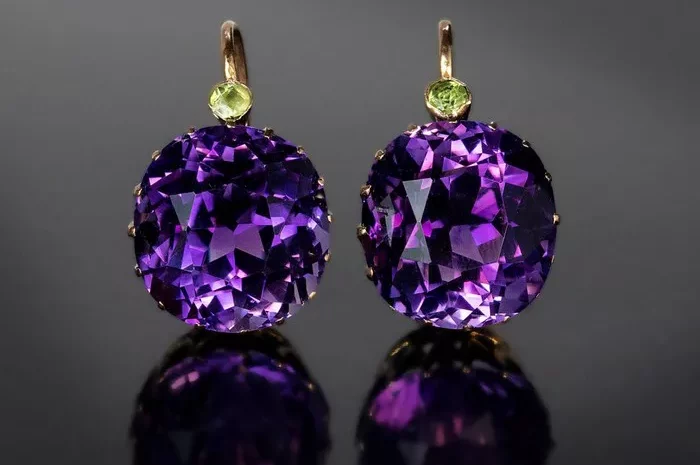Amethyst, with its captivating violet hues and rich historical tapestry, has long been revered across cultures for its multifaceted symbolism and purported spiritual properties. In this article, we delve deep into the world of amethyst, exploring its historical significance, spiritual and healing properties, physical characteristics, cultural and mythological associations, modern usage, geological formation, and connections to chakras and zodiac signs.
Historical Significance
The story of amethyst dates back thousands of years, with its first known uses tracing back to ancient civilizations. The name “amethyst” finds its roots in Greek mythology, where it was believed to ward off intoxication and promote sobriety. According to legend, the god Dionysus became enraged by an insult and vowed to unleash tigers upon the next mortal who crossed his path. Amethyst, a young maiden on her way to pay homage to the goddess Diana, was the unfortunate target. To protect her, Diana transformed Amethyst into a pure white stone. Seeing the consequences of his anger, Dionysus wept tears of wine, staining the stone purple and creating the gem we know today.
In ancient Egypt, amethyst held a position of high regard, often used in jewelry for its supposed protective properties. It was also associated with the deity Hathor, who embodied love, beauty, and motherhood. The use of amethyst in religious and ceremonial contexts was not limited to Egypt but extended to other cultures, including the Romans and the Catholic Church. Bishops in the Catholic Church historically wore amethyst rings as a symbol of spiritual wisdom and humility.
Spiritual and Healing Properties
Amethyst is renowned for its spiritual and healing attributes, believed to promote calmness, balance, and heightened spiritual awareness. In crystal healing practices, it is often used to alleviate stress, anxiety, and negative emotions. Its calming energy is said to soothe the mind and facilitate a deeper connection to one’s inner self.
The gemstone’s association with the Crown Chakra, the energy center at the top of the head, is particularly significant. It is believed that amethyst helps in opening and balancing this chakra, fostering a sense of spiritual enlightenment and higher consciousness.
For centuries, individuals have turned to amethyst during meditation to enhance focus and clarity. Its tranquil vibrations are thought to quiet the mind and create a conducive environment for introspection and spiritual growth.
Physical Characteristics
Amethyst, a variety of quartz, is characterized by its stunning purple coloration, ranging from pale lilac to deep violet. This color is attributed to trace amounts of iron within the crystal structure. Its crystal habit typically forms as six-sided prisms with pointed terminations, known as crystals or druses, which contribute to its aesthetic allure.
With a Mohs hardness of 7 on the scale of mineral hardness, amethyst boasts durability suitable for a wide range of jewelry applications. Its transparency can vary from translucent to transparent, enhancing its visual appeal when cut and polished into faceted gemstones or cabochons.
Cultural and Mythological Associations
The symbolism of amethyst transcends geographical boundaries, with diverse cultures attributing various meanings to this gemstone. In Chinese culture, amethyst is associated with wealth and prosperity, believed to attract good fortune and enhance one’s financial status.
Among Native American tribes, amethyst was often used in spiritual ceremonies to promote healing and purification. It was regarded as a stone of protection and clarity, guiding individuals on their spiritual journeys.
In addition to its Greek origins linked to sobriety, amethyst has been associated with mental clarity and focus, making it a favored gemstone among scholars and intellectuals throughout history.
Modern Usage
In contemporary times, amethyst continues to captivate enthusiasts not only as a precious gemstone in jewelry but also as a decorative element in home decor. Its regal hue adds a touch of elegance to interior spaces, whether in the form of polished geodes, sculptures, or accent pieces.
Moreover, the resurgence of interest in holistic wellness has fueled amethyst’s popularity in the crystal healing community. Many believe that placing amethyst clusters or geodes in living spaces can purify the energy and create a harmonious environment.
Geological Formation
Geologically, amethyst forms within cavities or fissures in rocks, commonly associated with volcanic activity. The presence of silica-rich solutions containing trace elements, such as iron, facilitates the crystallization process over millions of years. This slow crystallization under specific conditions gives rise to the characteristic prismatic crystals of amethyst.
Amethyst is predominantly found in regions with volcanic or geothermal activity, including Brazil, Uruguay, Zambia, and Russia. These geological environments provide the necessary conditions for the formation of sizable and high-quality amethyst deposits.
Chakra and Zodiac Connections
As mentioned earlier, amethyst is closely linked to the Crown Chakra, which governs spiritual awareness, wisdom, and enlightenment. By aligning with this chakra, amethyst is believed to promote a sense of spiritual connection and facilitate deeper insights into the nature of reality.
In terms of zodiac connections, amethyst is often associated with the signs of Pisces, Virgo, Aquarius, and Capricorn. Pisces, known for its intuitive and sensitive nature, resonates with amethyst’s calming and spiritually enhancing properties. Virgo, representing analytical thinking and attention to detail, finds synergy with amethyst’s clarity-promoting attributes. Aquarius and Capricorn also benefit from amethyst’s ability to foster mental acuity and spiritual growth.
In conclusion, amethyst stands as a timeless symbol of spiritual wisdom, clarity, and inner peace. Its rich history, coupled with its diverse cultural and metaphysical associations, continues to intrigue and inspire individuals seeking deeper connections to themselves and the world around them. Whether adorning jewelry, adorning living spaces, or serving as a tool for spiritual exploration, amethyst remains a cherished gemstone with enduring allure and significance.


